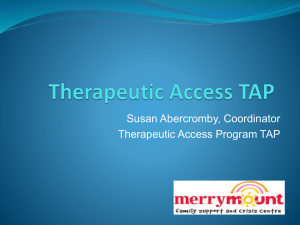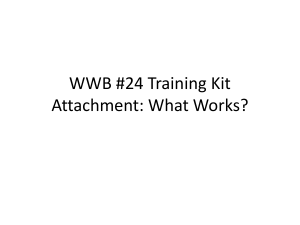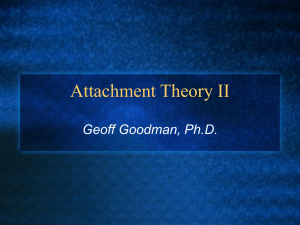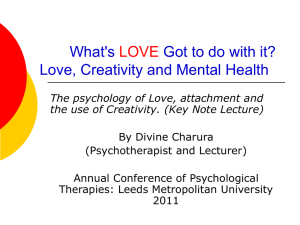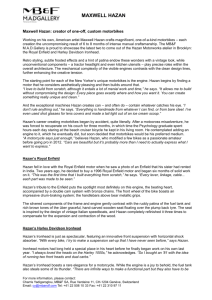Attachment theory in adulthood
advertisement
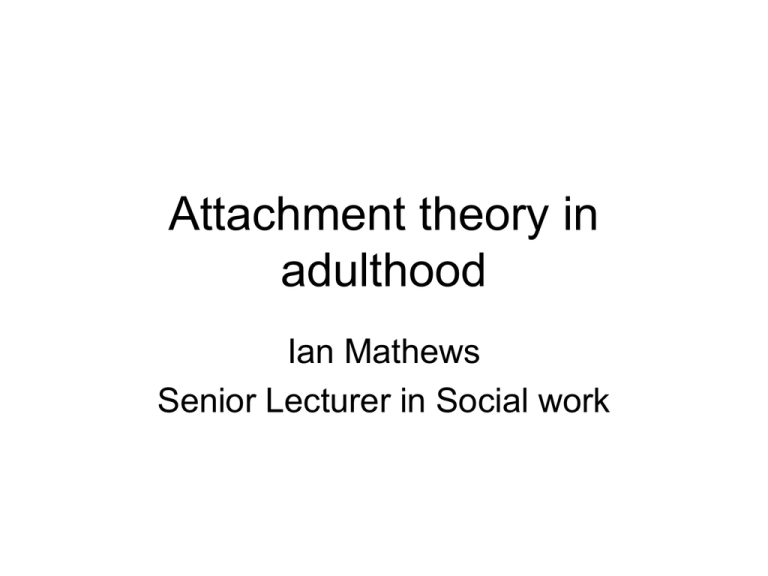
Attachment theory in adulthood Ian Mathews Senior Lecturer in Social work Attachment theory Do you remember… The basic premise; all children are born with an innate need to feel loved & wanted by their parents. If a child does not experience this it has a sense of emotional hurt that results in the child engaging in a range of behaviours designed to get the parent to love the child. Bowlby (1969) Million dollar question - does attachment influence relationships in adult life? What do you think? What did Bowlby think? Seminar 1 re-visited Childhood ~ Adulthood • Leaving home • Wanting more time to yourself, more time doing ‘your own thing’, increasing independence from your parents • Spending less time with your parents & increasing amounts of time with your friends • Developing other ‘significant relationships’ In other words, leaving home is ‘more than setting up a separate residence. It involves a highly significant psychological emancipation process in which the young person distances themselves emotionally from their parents to at least some degree.’ Bee (1994:334) How is this represented in stage theory? Erikson’s (1959) stage theory of ‘early adulthood’ The struggle between Intimacy versus isolation. The challenge here is to experience intimacy yet retain a secure sense of your identity Success leads to the establishment of close relationships with others Failure leads to isolation of the development of superficial adult relationships The changing nature of attachment in adolescence & early adulthood Proximity seeking; in adolescents commonly want to spend more time with their friends whilst thinking of their parents as being a safe base ( a specific attachment figures/s). Secure base; over time this security transfers onto a partner or spouse Sense of self, sense of belonging; increasingly supplied by work colleagues & friendship groups rather than parents The return of the Million dollar question - does attachment influence relationships in adult life? The influence of attachment on adult relationships • Hazan and Shaver (1987) interviewed over 600 adults of varying ages & asked them to choose which of three descriptions best described their ‘significant relationship’ • They argued that the description chosen by the person reflected the adults experience of attachment in childhood ( is there a problem here… Hazan and Shaver research • ‘I am somewhat uncomfortable being close to others: I find it difficult to trust them completely, difficult to allow myself to depend on them. I am nervous when anyone gets too close, and often others want me to be more intimate than I feel comfortable with.’ (avoidant; chosen by ?%) • ‘I find it relatively easy to get close to others and am comfortable depending on them and having them depend on me. I don’t worry about being abandoned or about someone getting too close to me’. (secure; chosen by ?%) • ‘I find that others are reluctant to get close as I would like. I often worry that my partner doesn’t really love me or won’t want to stay with me. I want to get very close to my partner and this sometimes scares people away.’ (anxious/avoidant; chosen by ?%) And the consequences of these types of relationship • Research suggests that people end up in relationships with partners who confirm their existing beliefs about attachment relationships (Brennan & Shaver 1995) • Overall secure adults tend to be more satisfied in their relationships than insecure adults. • Secure adults are more likely to seek support from their partners when distressed. • They also provide more consistent support for their partners • Insecure adults cited inability to trust as a cause of breakdown in their relationships The experience of childhood attachment & how this transfers to parenting/adulthood What does research tell us; • A mother’s attachment pattern measured during pregnancy predicted their own child’s attachment pattern at 12 months in ?% of cases ( Fonagy, 1994) • It would appear that both the experience of attachment in childhood & the experience of attachment/key relationships affect the way parents parent Does poor attachment in childhood lead to psychological problems in adulthood? ‘As adults, the preoccupying anger with childhood attachment figures who let you down continues as does the search for unconditional love & for the perfect relationship.’ Schofield & Beek (2006:114-5) The social/trauma model of mental health • • • • • Anger can be internalised leading to; Self harm; the need to relieve stress & anger Suicide; the need to end the pain Eating disorders; the need to be in control Substance misuse ( alcohol/drugs); the need to dull the pain Depression • • • • Anger can be externalised leading to; Domestic violence Child abuse General violence Inability to control anger Sally Plumb So what… Children with a poor experience of attachment are likely to • struggle with adult relationships • replicate that poor experience with their own children • experience psychological problems in adulthood But it is important to recognise that people can & do change & not to be deterministic References Bee, H(1994) Lifespan development, New York, Harper Collins Bowlby, J (1969) Attachment & Loss; volume one; Attachment, London, Hogarth Press Brennan, K.A & Shaver, P. (1995). Dimensions of adult attachment, affect regulation, and romantic relationship functioning. Personality and Social Psychology Bulletin, 21, 267-284. Erikson, E (1959) Identity & the life cycle, New York, International Universities Press Fonagy, P et al (1994) The theory & practice of resilience, Journal of Child Psychology & Psychiatry 35:231-57 Hazan, C & Shaver, P. (1987) Romantic love conceptualised as an attachment process’, Journal of Personality & Social Psychology, vol 59 270-80 Schofield, G & Beek, M (2006) The Adoption handbook, London, BAAF




